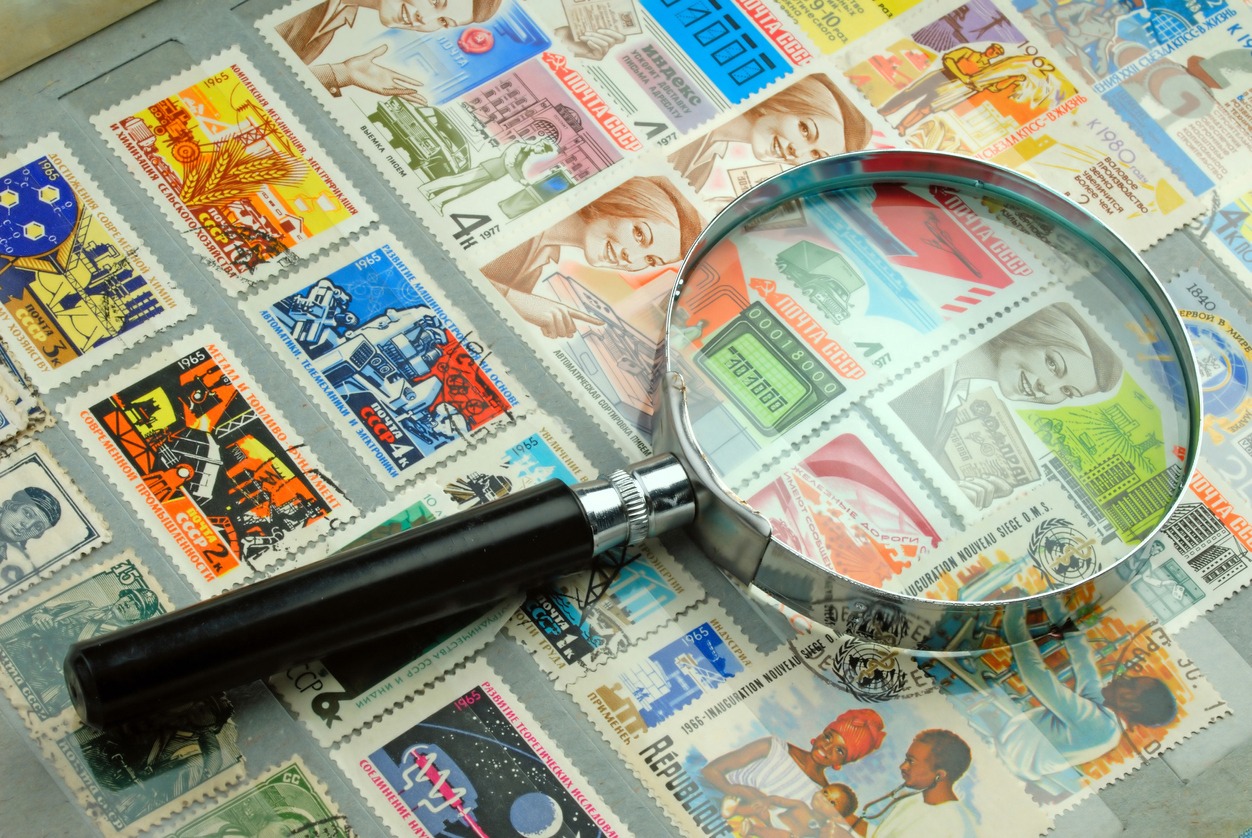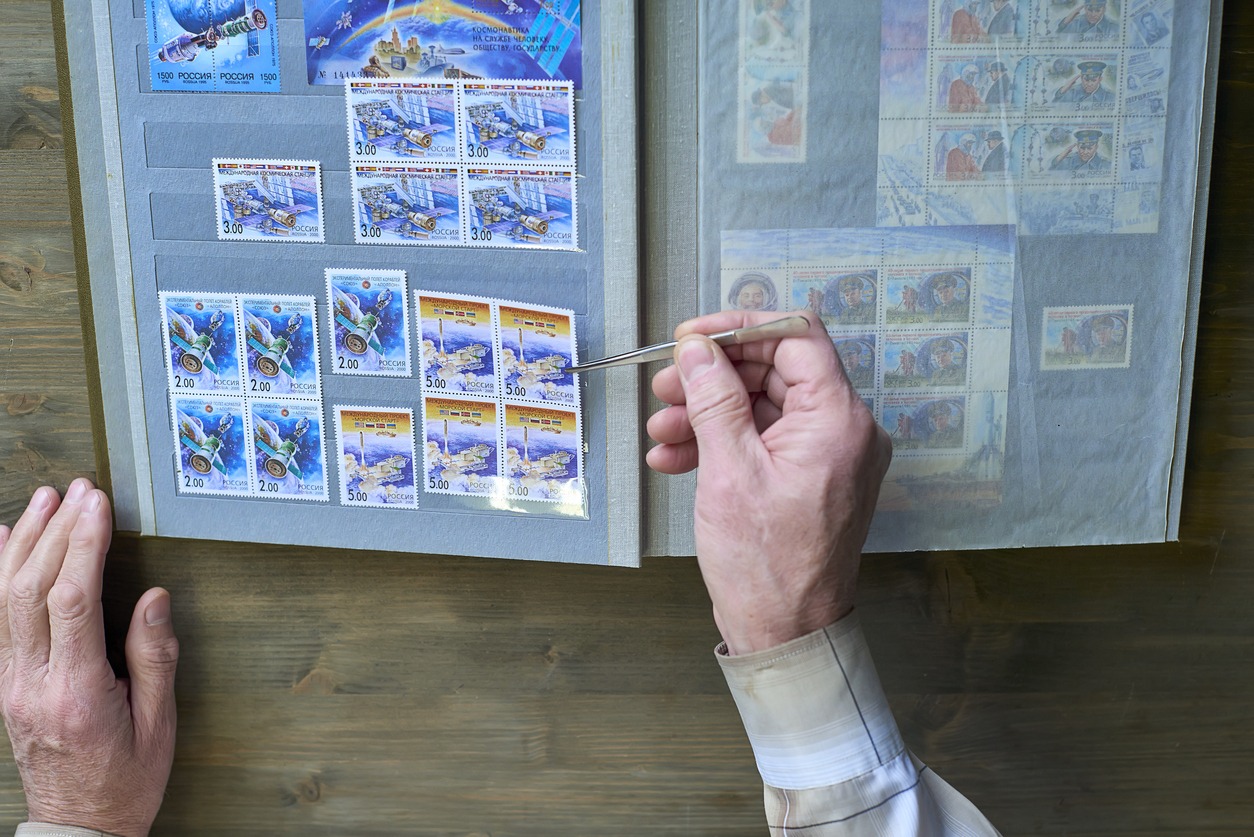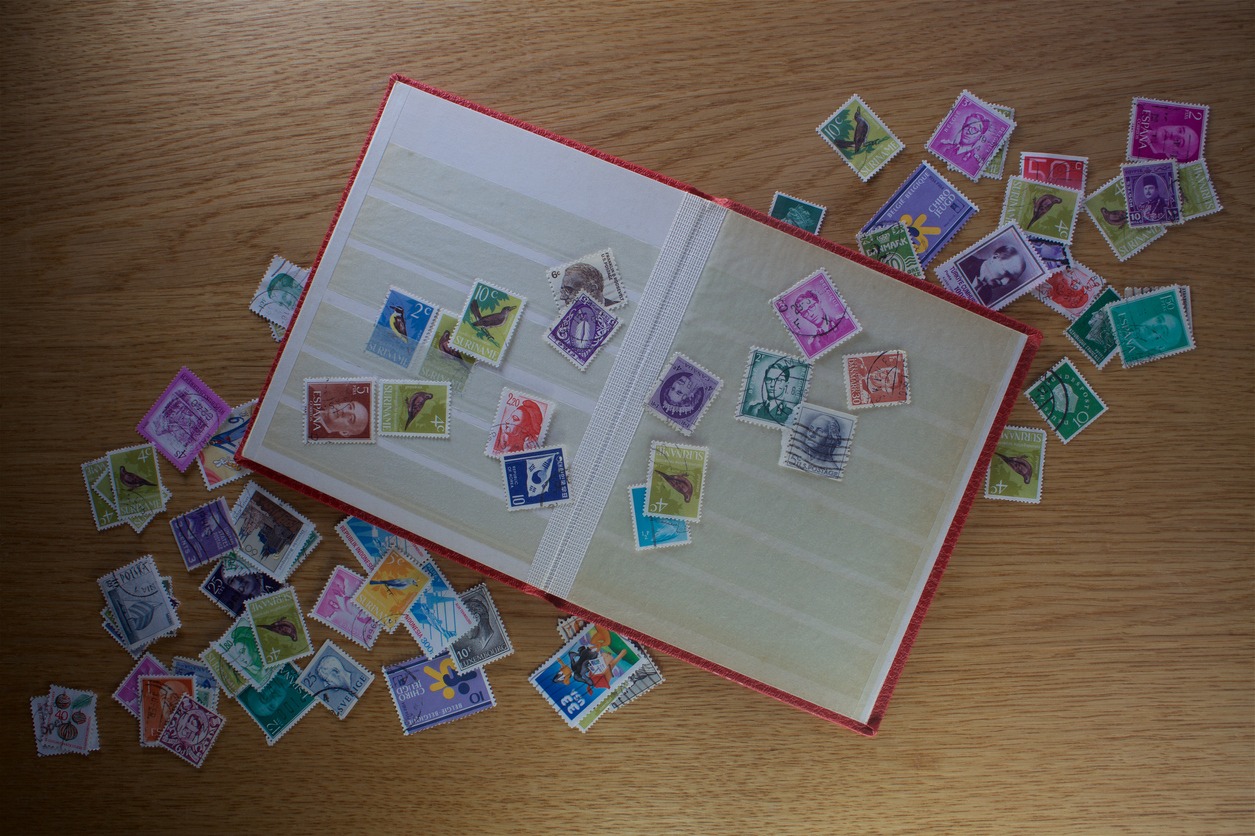You might find yourself in possession of a valuable stamp collection, whether you’ve inherited it or decided to explore the world of philately. Preserving your stamp collection properly is vital to protect your investment in the long run. Even though stamps are designed to endure the postal system, they are delicate pieces of paper that can easily tear or get damaged. Neglecting their care can significantly reduce their value over time.
In this article, we’ll cover the fundamentals of storing and preserving your stamp collection.
Handling Stamps with Care
A fundamental rule for anyone entering the world of philately is simple but crucial: Avoid touching the stamps with your fingers. While fingerprints are unique, they all share a common trait—grease, dirt, and grime. These can easily transfer onto your stamps and cause damage. To protect your delicate collection, always use stamp tongs instead of regular tweezers. Stamp tongs have smooth jaws designed to prevent tearing while allowing you to handle stamps gently. Using tongs effectively may take a bit of practice, so it’s a good idea to start with less valuable or easily replaceable stamps.
In the world of stamp collecting, you’ll discover a wide array of specialized stamp tongs available for purchase, catering to various preferences and price ranges.
Essential Stamp Collecting Equipment
To properly care for your stamps, you’ll need a few basic tools:
- Stamp tongs: These are essentially tweezers with rounded ends specially designed for handling stamps. They prevent fingerprints and smudging while making it easier to pick up stamps. Some collectors prefer having two pairs of tongs: one for holding the stamp and the other for keeping the stock page steady while placing the stamp.
- Magnifying glass: An essential tool for examining the intricate details of your stamps.
- Perforation gauge: This device helps you measure the distance between perforations, often expressed as the number of perforations in every 2cm of length. It’s a crucial tool for identifying rare stamps, as similar-looking stamps may have different perforations.
- Stamp catalogue: Numerous stamp catalogs are available, offering valuable information about your stamps. Popular options include the Stanley Gibbons and the Scott Catalog, providing insights into stamp details and values.
By following these guidelines and investing in the right tools, you can ensure the longevity and preservation of your stamp collection.
Tips for Properly Storing Your Stamp Collection
Stamps are among the most delicate and ephemeral collectibles, requiring careful storage to prevent tears and damage. Whether you’ve recently inherited a stamp collection, are new to the hobby, or have long been a stamp enthusiast, here are some valuable tips to protect your investment and preserve your stamps for the long haul.
- Use stamp tongs: Always handle your stamps with stamp tongs. These specialized tools have smooth jaws that prevent tearing while allowing you to grasp stamps delicately. Avoid using your fingers, as they can leave behind dirt and grease.
- Maintain ideal temperatures: Store your stamps in an environment with temperatures ranging between 65–72°F (18–22°C). Extreme heat or cold can harm stamps, so steer clear of locations like attics, basements, garages, or areas prone to temperature fluctuations.
- Control humidity levels: Keep humidity in check, ideally between 25–55%. Excess humidity can cause stamps to warp, develop mold, or accumulate mildew.
- Minimize sunlight exposure: Natural sunlight can cause stamps to fade, change colors, and develop cracks, just like fabrics and paintings. To prevent this, store your stamps in a dark cabinet or container.
- Elevate your collection: Store your stamp collection well above ground level to reduce the risk of water damage from floods and prevent pests from crawling over your stamps.
Potential Risks to Your Stamp Collection
Taking precautions to safeguard your stamp collection involves being aware of various factors that can harm your prized possessions. Here’s a closer look at some of the key considerations and protective measures:
- Humidity concerns: Humidity, particularly when storing stamps at home, can vary significantly and lead to issues like warping mold, and mildew growth. It can also damage gum, reducing a stamp’s value. Maintain a stable humidity level between 35% and 55% by using environmental controls like humidifiers or dehumidifiers.
- Temperature effects: Extreme temperatures and frequent fluctuations can harm stamps as materials expand and contract. Avoid storing your collection in areas prone to temperature extremes, such as attics, basements, or garages. The ideal range is 65°F to 72°F (18–22°C).
- Light exposure risks: Prolonged exposure to sunlight can fade, discolor, yellow, and crack stamps. Protect your collection from excessive natural light by storing it in a dark cabinet instead of displaying it prominently.
- Water damage: Accidental spills can lead to stamp warping, deterioration, fungal growth, and gum damage. Prevent potential water damage by avoiding drinks near your collection and storing stamps at least 6 inches above the floor.
- Chemical exposure: Chemical damage can occur from aerosol sprays, perfumes, dirt, and grime. These substances can attach to stamps and cause deterioration. Store stamps in airtight containers and remain cautious while cleaning or working around your collection.
- Improper handling: Proper handling techniques, using stamp tongs, can prevent damage by force, including rips, tears, warping, and scratching. Ensure that your collection is stored safely away from untrained handlers and protected from vibrations or impacts.
- Pest protection: Pests like mice, insects, and microorganisms are drawn to organic materials like paper, posing a significant threat to your collection. Avoid cardboard or paper containers for storage and take measures to prevent infestations, like sealing entryways.
- Fire hazards: Fire and smoke can cause catastrophic damage. Installing smoke alarms and having fire extinguishers in your home is essential. For highly valuable collections, consider investing in a fireproof safe for extra protection.
- Neglect and record-keeping: Consistently maintaining and updating records about your collection is crucial. This helps with insurance purposes in case of any unforeseen incidents. Make sure to back up these records electronically or keep hard copies.
- Theft prevention: While most thieves may not understand the value of stamps, preserving and storing collections carefully can signal their worth. Consider securing high-value or irreplaceable stamps in a locked area and avoid ostentatious displays that might attract unwanted attention.
By staying vigilant and addressing these potential risks, you can ensure the long-term preservation and safety of your cherished stamp collection.
Stockbooks vs. Albums
When it comes to storing your stamp collection, two common options are stockbooks and albums. Stamp albums are designed for specific themes, countries, or time periods, providing designated spaces for stamps along with explanatory text. Albums help with organization but have limited flexibility. On the other hand, stock books offer a blank canvas for arranging stamps as you wish, allowing greater freedom.
When choosing between stock books and albums, consider these factors:
- Cover and paper quality: Assess the material and quality of the cover and paper.
- Paper color: Many collectors prefer black paper for displaying stamps.
- Interleaving: Look at the type and material of interleaving (clear or glassine strips that offer additional protection between pages).
- Binding type: Examine the type of binding used in the book.
To maintain your collection’s condition:
- Avoid overstuffing: Don’t overcrowd an album or stock book, which can damage pages and stamps.
- Upright storage: Keep your albums and stock books upright to distribute weight and pressure evenly.
Mounting Methods
When attaching stamps to an album, you have three options:
- Direct attachment: Affixing new stamps directly to an album or stock book may diminish their collectible value. It’s generally not recommended.
- Hinging: Stamp hinges transparent tape, can attach stamps while preserving features like watermarks. High-quality hinges can be removed without causing harm but may leave a residue.
- Mounting: Although costly, stamp mounts offer the best preservation for valuable issues without causing damage. They securely hold stamps in an album, making them the preferred choice for long-term storage and protection of valuable collections.
If you like documenting the story behind how you got your precious stamps, you can take behind-the-scene clips and produce a mini-documentary video of yourself and your collection by learning video editing!
Stamp Care Essentials
Preserving your stamp collection requires diligence and good practices. Here are ten key habits for stamp collectors:
- Put new stamps away immediately. Leaving them out risks damage or loss.
- Avoid touching stamps with your fingers, which can transfer oils and moisture.
- Be careful when mounting stamps in albums to prevent damage and maintain their appearance.
- Prevent stamps from hooking onto each other when turning pages to avoid bending and creasing.
- Keep albums out of reach of children and pets who might damage or play with them.
- Food, drinks, and cigarettes can harm your collection. Avoid spills and crumbs near stamps.
- Keep stamp tools and supplies neatly stored for easy access and to prevent loss.
- Take time to become proficient with stamp tools like tongs, perforation gauges, watermark trays, and UV lamps.
- Utilize stamp catalogs to identify and learn about your stamps. Read the introductory sections for valuable information.
- Join stamp clubs and organizations like the American Philatelic Society (APS) to connect with fellow collectors, share knowledge, and enhance your hobby.
Determining the Value of Your Stamp Collection
Once you start collecting stamps, you’ll surely get curious about the value of your collection. You can use references like the Scott Specialized Catalogue of United States Stamps and the Stanley Gibbons Stamp Catalogue, which provide photos and price listings sorted by issue date. Philatelic shops often sell price guides, too. Keep in mind that these guides typically reference stamps in above-average condition, so use the following criteria to evaluate your stamp collection’s value:
- Centering:Start by examining the centering of your stamps. Stamps with nearly equal margins are more visually appealing and tend to sell for higher prices. The design should appear balanced in relation to other parts of the stamp, like the margin and vignette. Poor centering can result from misalignment during the perforation process, particularly on stamps from 1857 that were originally designed as imperforates.
- Condition: Stamp condition is a crucial factor in determining value. Stamps with missing perforations, faded colors, paper flaws, or other imperfections are worth less. Stamps are usually graded on a scale from superb to below average:
- Superb: These stamps are top-quality, with near-perfect centering, brilliant color, and perfect gum.
- Fine: These stamps are without significant flaws, have average centering light hinge marks, and are not as fresh as superb stamps.
- Good: These stamps are noticeably off-center but still fairly attractive, with minor defects like thin areas and heavy hinge marks. Anything below “good” is typically not desirable for experienced collectors and may be used as “space fillers.”
- Gum: Stamp gum refers to the adhesive on the stamp’s back. The most valuable stamps have original, undamaged gum, often described as “mint, never hinged.” Here are the gum conditions:
- Mint: Stamps with full, undamaged original gum, as issued by the post office.
- Unused: Stamps with original gum that has been damaged, often due to the use of stamp hinges.
- Unused without gum: Stamps that have lost their original gum.
- Rarity: The rarity of a stamp depends on several factors, like printing errors, content, and perforation mistakes. Limited-issue stamps with a small number of copies are also considered rare. You may need the opinion of a philatelist or an expert to determine rarity accurately. Auction price databases can be useful in assessing how often a stamp appears on the market. Rare stamps become scarcer over time as collectors add them to their private collections.
For many collectors, the allure of stamp collecting lies in the intricate designs and the rich history and cultures they represent. But for some, what makes stamp collecting truly exciting is the prospect of owning rare and valuable stamps that could turn a profit.
Indeed, stamp collecting can be a potentially profitable hobby, with some rare stamps commanding astonishing prices at auctions. Here’s a look at the top six most expensive stamp sales in history:
- British Guiana 1c Magenta (1856) – Sold for $9.48 Million
- Treskilling Yellow (1855) – Sold for $2.6 Million
- The Sicilian Error of Color (1859) – Sold for $2 Million
- Baden 9 Kreuzer Error (1851) – Sold for €1.31 Million
- The Inverted Jenny (1918) – Sold for $1.35 Million
- 1c Benjamin Franklin Z Grill (1868) – Sold for $935,000
These remarkable figures demonstrate the potential for stamp collecting to be a financially rewarding investment. However, it’s essential to understand that these are extraordinary and rare cases. Most stamps do not come anywhere close to fetching such high prices. The reality is that standard, commonly available stamps typically have limited value because millions of copies were printed.
While it is possible to build a valuable collection by focusing on rare stamps, doing so would require a significant financial commitment. Like many things in life, the return on investment in stamp collecting is not guaranteed, as the stamp market can be unpredictable. For those considering stamp collecting solely for the purpose of making a quick profit, it may be more prudent to explore other collectibles.
However, for those passionate about stamps and willing to invest time and money wisely, building a valuable stamp collection is entirely achievable with the right knowledge and approach.
Insuring Your Stamp Collection
No matter how careful you are with your stamp collection, accidents can still happen. While we cherish stamps for their beauty and historical significance, it’s important to remember that a substantial stamp collection represents a significant financial investment. Just as you would protect any valuable asset, it’s essential to take steps to safeguard your collection.
When considering insurance for your stamp collection, there are a few key factors to keep in mind. Firstly, it’s worth noting that your homeowners’ insurance might offer some level of coverage. However, most policies come with limits on the amount they will pay out for damage to collectible items, and these limits can be relatively low, sometimes just a few hundred dollars. It’s crucial to check with your current insurer to understand the extent of your coverage. In many cases, you can enhance your policy by adding additional coverage specifically tailored to your high-value collection.
Conclusion
The world of stamp collecting is a fascinating journey through history, art, and culture, making it a cherished hobby for many enthusiasts. Preserving and taking care of these tiny treasures requires attention to detail and a commitment to safeguarding their value. Whether you’re a seasoned philatelist or just starting your stamp-collecting adventure, this guide can help you ensure your collection remains a source of joy, knowledge, and even potential investment for years to come.



